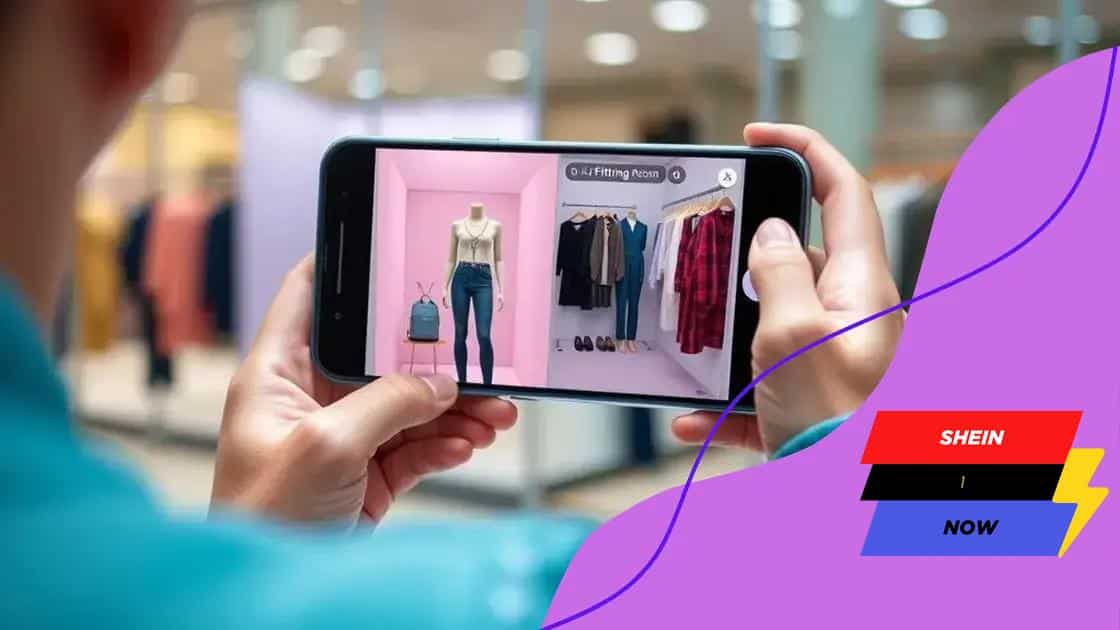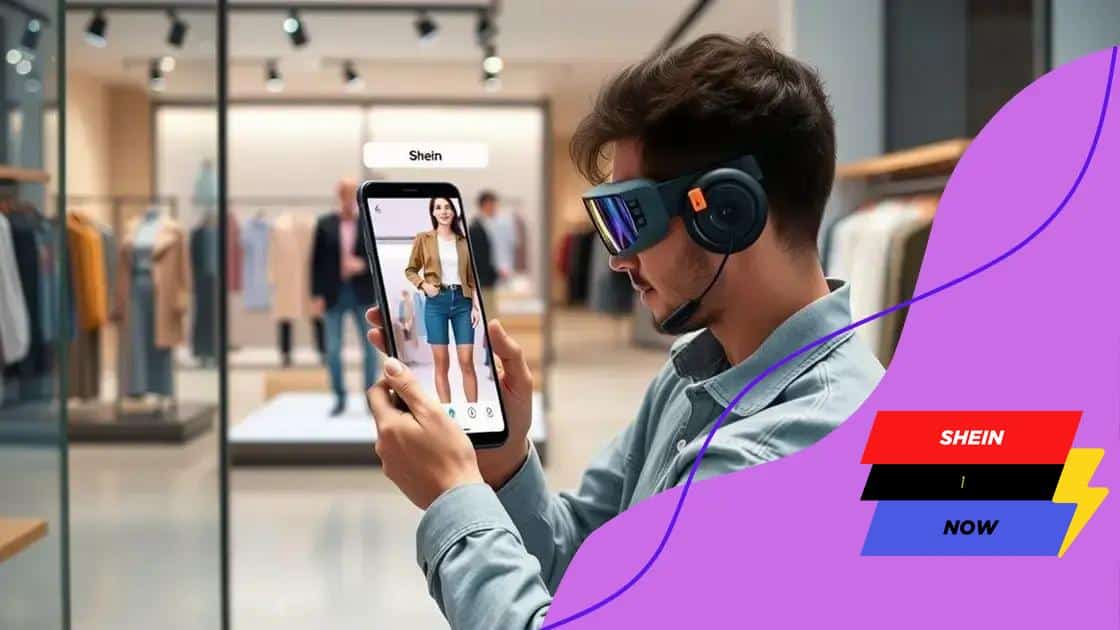Shein’s use of augmented reality in shopping

Shein’s use of augmented reality in shopping enhances the consumer experience by allowing virtual try-ons and personalized product visualization, leading to increased confidence in purchases and reduced returns.
Shein’s use of augmented reality in shopping is changing the game for online consumers. Imagine being able to try on clothes virtually from the comfort of your home. This innovative approach is worth exploring, don’t you think?
What is augmented reality in shopping?
Augmented reality in shopping is a technology that blends digital information with the real world. It enhances our shopping experience by allowing us to visualize products in a more interactive and engaging way. With augmented reality, customers can see how products look in their own space or try on virtual clothing, making online shopping feel more personal.
This innovative technology has taken online and in-store shopping to a whole new level. Imagine walking into a store and using your device to see how a piece of furniture might fit in your living room or how a new outfit looks on you without ever trying it on. Augmented reality bridges the gap between physical and digital shopping.
How does it work?
At its core, augmented reality uses your smartphone or tablet camera to overlay digital images onto the real environments you see. Here are some key features:
- Facial recognition to try on makeup or glasses.
- 3D models to visualize products in your home.
- Interactive features that allow you to customize products.
With features like these, augmented reality helps buyers feel more confident in their purchase decisions. It significantly reduces the uncertainty that comes with online shopping.
Major retailers, like Shein, are adopting augmented reality to improve customer engagement. For instance, users can try on clothes virtually, making shopping much more enjoyable and interactive. This technology not only enhances the fun aspect of shopping but also increases the likelihood of making a purchase as consumers can better visualize how the products will fit into their lives.
Benefits of augmented reality in shopping
- Enhanced decision-making process.
- Reduction in product returns due to better visualization.
- Increased customer satisfaction and engagement.
In summary, augmented reality in shopping provides a unique and compelling way to enhance the retail experience, making it more interactive and customer-centered. By using these innovative tools, retailers are not just selling products; they are offering experiences that customers will remember.
Benefits of augmented reality for consumers
The benefits of augmented reality for consumers are numerous and exciting. This technology not only enhances the shopping experience but also helps shoppers make informed decisions. Imagine being able to see how a piece of furniture fits in your home or how that dress looks on you without even stepping into a store.
With augmented reality, consumers can enjoy a more personalized shopping experience. They can visualize products in their own surroundings, which makes it easier to choose what to buy. This visualization helps to eliminate guesswork and boosts confidence in the purchasing process.
Key advantages include:
- Improved Product Visualization: Shoppers can see products in 3D, helping them understand size, color, and style better.
- Reduced Returns: By trying items virtually, consumers are less likely to buy items that don’t meet their expectations.
- Enhanced Engagement: AR creates a fun and immersive shopping experience that keeps consumers interested.
Moreover, augmented reality can save time. Instead of visiting multiple stores or scrolling countless online pages, customers can try on different styles quickly. This efficiency makes shopping enjoyable and less stressful.
Additionally, it fosters a sense of connection between consumers and brands. As companies like Shein incorporate augmented reality, they create memorable experiences that resonate with their audience.
Increased Accessibility:
Augmented reality is also beneficial for consumers with disabilities. By providing virtual experiences, brands can ensure that all users have the opportunity to engage with their products meaningfully.
Overall, as technology advances, the benefits of augmented reality will continue to shape consumer experiences, making shopping easier, engaging, and more accessible.
How Shein implements augmented reality techniques

Shein is at the forefront of incorporating augmented reality techniques in the retail space, transforming how consumers interact with fashion. By leveraging AR, Shein allows customers to visualize products in real-time, making the shopping experience more immersive and engaging.
The brand uses augmented reality to enhance the online shopping journey. For instance, shoppers can use their smartphones to try on clothing virtually. This technology overlays a digital rendering of the garment onto the user’s image, helping them see how it fits and looks without physically trying it on. This feature not only boosts confidence in purchasing but also adds an element of fun.
Key features of Shein’s AR implementation:
- Virtual Try-On: Customers can see how clothes fit their body shape, allowing for a personalized experience.
- Augmented Product Displays: Users can view detailed 3D models of items, rotating them to see all angles.
- Interactive Shopping Experience: Shein encourages users to engage with products more deeply through AR, keeping them intrigued.
This innovative approach reduces the chances of returns, as buyers are better informed about their choices. Additionally, Shein frequently updates its AR features based on customer feedback, ensuring continuous improvement and relevance in the competitive market.
The integration of augmented reality has also extended to marketing campaigns. Shein often utilizes AR filters on social media platforms, allowing users to share their virtual try-on experiences. This not only drives user engagement but also promotes brand visibility.
As Shein continues to evolve its technology, the focus remains on enhancing customer satisfaction and creating memorable shopping experiences. By implementing AR, they set a standard for the future of online fashion retail.
Impact of augmented reality on shopping behavior
The impact of augmented reality on shopping behavior is significant and profound. As more consumers embrace technology, AR is changing how people approach their shopping experience. It’s not just about buying items; it’s about engaging with brands in new and exciting ways.
Augmented reality makes shopping more interactive. When customers use AR features, they can visualize products in their own space, which enhances their confidence in purchasing. This visual confirmation helps shoppers feel more connected to the products, leading to quicker purchasing decisions.
Effects of AR on consumer behavior:
- Increased Engagement: AR keeps consumers interested by making the shopping experience fun and interactive.
- Higher Conversion Rates: As users become more confident in their choices, businesses experience fewer cart abandonments and more completed purchases.
- Enhanced Brand Loyalty: When shoppers have enjoyable and memorable interactions, they are likely to return to the brand.
Another notable effect of AR is the reduction in product returns. When shoppers can see how clothing or furniture will look in their own lives, they make better-informed decisions. This not only benefits consumers but also helps retailers cut down on return costs.
Moreover, the use of augmented reality is reshaping marketing strategies. Brands are employing AR in advertising to capture attention and drive traffic to their websites. AR-driven promotions often lead to increased click-through rates and engagement on social media.
Through the collaborative use of AR, both consumers and retailers can have a more fulfilling shopping experience. Shoppers enjoy the convenience of making well-informed choices, while businesses benefit from increased sales and customer satisfaction.
Future trends in augmented reality for online retail
The future trends in augmented reality for online retail are exciting and full of potential. As technology advances, we can expect to see even more innovative applications of AR, shaping the way consumers shop online.
One significant trend is the increased integration of artificial intelligence with AR. This combination will enable retailers to offer personalized experiences tailored to individual preferences and shopping habits. For example, AI can analyze a user’s past behavior to suggest products while enhancing the AR experience to show how those products fit into their lifestyle.
Potential developments include:
- Advanced Virtual Try-Ons: Enhanced fitting technology will allow customers to see clothes on their virtual selves in more realistic ways.
- Seamless Shopping Experiences: Integrating AR with mobile wallets will enable one-click purchases directly from AR displays.
- Social Commerce: Shoppers will interact with friends and influencers in AR environments, making shopping a more social activity.
Furthermore, we might see AR become a more commonplace feature in social media marketing. Brands may create AR filters and experiences that allow users to try out products virtually and share their experiences with friends, enhancing brand visibility and engagement.
As online retail evolves, AR will likely enhance logistical aspects, such as virtual inventory checkers and 3D product placements. This technology will streamline operations and improve the shopping experience for consumers.
Additionally, more retailers will invest in creating AR-enabled apps as consumers demand interactive and engaging experiences. The ability to visualize products in their environment or on themselves fosters confidence in purchases, which is crucial in online shopping.
FAQ – Frequently Asked Questions about Augmented Reality in Shopping
What is augmented reality in shopping?
Augmented reality in shopping is a technology that overlays digital information and images onto the real world, allowing consumers to visualize products in an interactive way.
How does augmented reality improve the shopping experience?
Augmented reality enhances the shopping experience by allowing customers to try on clothes virtually and see how products fit in their space, increasing confidence in their purchases.
What are the benefits of using augmented reality in retail?
The benefits include improved customer engagement, reduced product returns, and increased sales as consumers feel more assured about their purchases.
What future trends can we expect in augmented reality for online retail?
Future trends may include advanced AI integration for personalized experiences, more seamless shopping interfaces, and greater use of AR in social media marketing.





